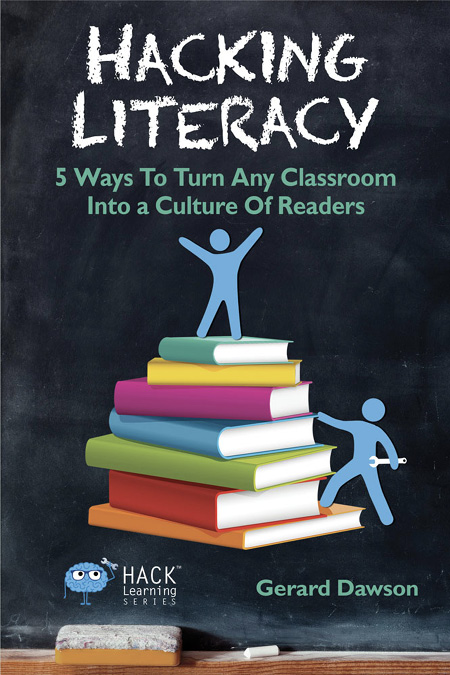Required Reading is a Drag You Can Easily Fixed
Jan 20, 2022
Most students hate required reading. Hacking Literacy author Gerard Dawson explains how to improve this issue with the 80/20 Analysis in the Hack Learning Podcast episode above.
Here are the highlights:
The Problem: Required Reading is a Drag
Many literacy teachers face a conundrum: They are handed a stack of dusty novels or an aging anthology and told to teach the texts by June.
The problem?
These texts are often inaccessible to students.
Why are required texts often so inaccessible? These texts are often not modern. They may occur in a different historical, geographical, or cultural setting than the setting of your classroom.
They are often written at a reading level that may far exceed that of your students, and the characters’ experiences may not immediately appear relevant to your students’ lives.
Consider the text my (Gerard's) current sophomore students are reading: Arthur Miller’s seminal drama, The Crucible.
This play was written in the 1950s but set in the 1690s. The characters speak in an often-confusing syntax. The characters live in an isolated, super-religious community, with few immediate parallels to my students’ lives. And it is written as a play, which students are less familiar with reading than a novel.
With all that working against us, we can still make the required texts work for our students.
But it takes a hack.
The Hack: Use 80/20 Analysis
This style of thinking, which I first encountered in Tim Ferris’s best-selling The 4-Hour Work Week, involves examining how we spend our time to determine the areas of our life that lead to the best results and those that lead to the biggest headaches.
In this case of teaching required texts, it means to stop thinking of the required text as a massive log that must be cut with a handsaw, and instead, a perfect piece of lumber that you can craft into whatever you need it to be.
In other words, abandon the notion of just getting through the book. Cut away all that’s unnecessary in your teaching of required texts. You’ll be left with:
- The parts of the text that are most engaging to students and relevant to your instructional goals
- The lessons, assessments, and other readings that help students to meet those instructional goals
For many students, reading required texts means reading at or above the upper end of their ability, forcing them through 200 pages of a novel far above their reading level? That will lead to disengagement, frustration, and students taking shortcuts to “beat” your assessments.
But by providing good teaching and proper support, we can help students benefit from reading and studying the essential parts of a required text.
These short, focused bursts of rigorous reading, when supplemented with relevant nonfiction reading and student-appropriate independent reading, will stretch students’ literacy skills more than the bored-to-death approach that is typical with required reading.
- Get clear on your objectives by listing the skills, content, and essential questions that you want students to experience during your text-based unit. For example, are you teaching The Giver, or are you teaching students to think deeply about the question, “What is a perfect society?”
- Read with a pen and note the essential 20 percent of the required text that helps you meet your objectives. In a novel, it may be an excerpt where the author demonstrates her style; in a play, it may be a scene where the dialogue reveals important themes.
- Visit your favorite news sites to find current relevant current events for your required text. For example, when teaching The Crucible, students read articles about modern-day witch hunts (the treatment of Arab-Americans after 9/11, the search for steroid users in baseball, etc.).
- Combine essential excerpts of the required texts with short articles to build fiction/nonfiction “text sets.” Use this to engage students in meaningful reading, writing, and thinking about important big ideas and essential questions.
- Check YouTube and Audible for video performances and audio versions of the text. I’m not suggesting watching the entire movie version of a book or listening to a whole audiobook in place of reading. However, for challenging scenes (or ones that are less important to analyze), students may benefit from a multimedia experience.
- Revive boring assessments allowing students to apply creativity to demonstrate understanding of content and skills. Have students gather costumes and props, then read aloud an excerpt of a play to demonstrate understanding of tone and stage directions. Have students write a bonus scene from a novel to demonstrate understanding of characterization and the author’s style. Again, use 80/20 thinking to throw out assessments that serve the teacher and keep the stuff that assesses the learning and engages the learner.
- Find thematically related YA books or other texts that are accessible to your students. Of course, we want our students to read challenging, grade-level texts independently. But just as you can’t teach a student pre-algebra by assigning them calculus problems, you can’t help them read better independently by exhausting them with texts far beyond their reading level.
Overcoming Pushback
The curriculum requires the whole text. This may be true, but does that mean students must slog through every chapter? Can the class read, analyze, and discuss the essential excerpts together while students listen to, watch, or even read summaries of the less important parts?
Students need the experience of reading a rigorous text. This hack does not suggest abandoning whole class texts altogether (though in some situations, that may be appropriate). Instead, choose the best parts of the text to challenge your students.
When you carefully examine 1-2 pages of a novel, instead of slogging through a close reading of all 200 pages, students will be more focused and willing to push themselves into the deeper reading required by a challenging text.






